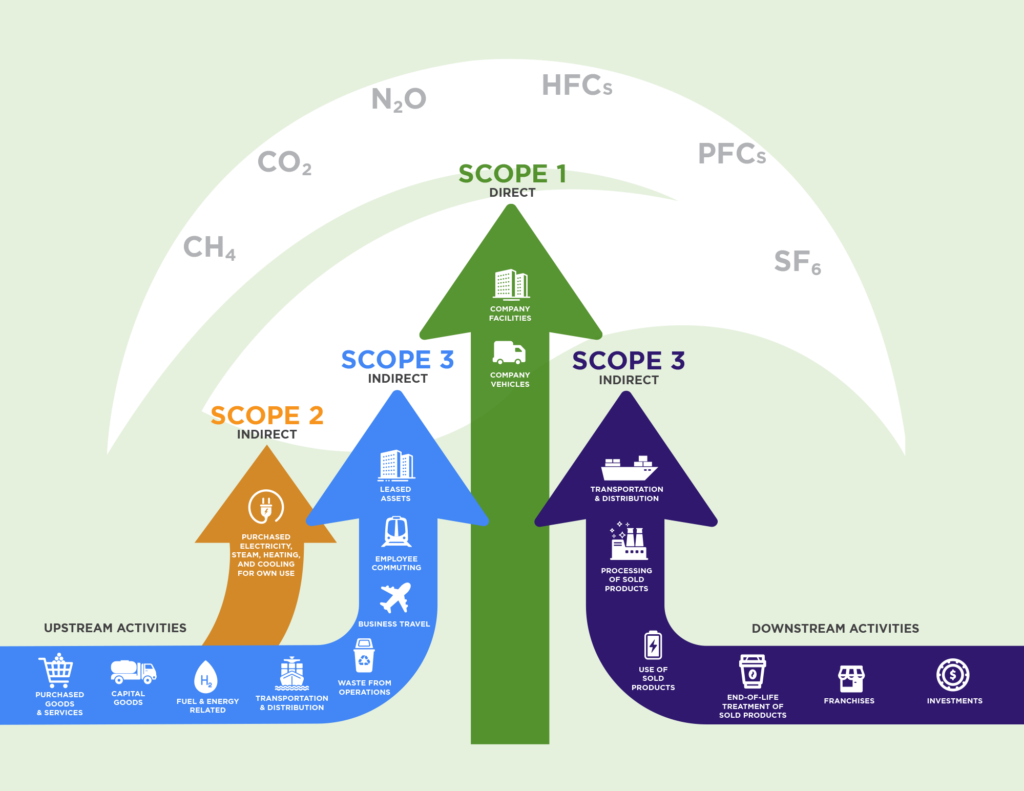Navigating Scope 1, 2, and 3 Emissions Reporting
In the fight against climate change, understanding and managing GHG emissions is critical for businesses worldwide. Scope 1, 2, and 3 emissions reporting not only aids in transparency but also enhances a company’s ability to make informed decisions toward sustainability objectives. Here, we review effective strategies and novel approaches for tackling the complexities of GHG emissions across all scopes.
Understanding the Scopes of Emissions
First, let’s review what Scope 1, 2, and 3 emissions entail:
- Scope 1 emissions are direct emissions from owned or controlled sources, such as fuels burned in company vehicles or facilities.
- Scope 2 emissions cover indirect emissions from the generation of purchased electricity, steam, heating, and cooling consumed by the reporting company.
- Scope 3 emissions, often the most challenging to calculate, include all other indirect emissions that occur in a company’s value chain, including both upstream and downstream activities.

Strategic Approaches to Reporting and Reduction
Before diving into specific strategies for managing Scope 1, 2, and 3 emissions, it is important to recognize the strategic value of accurate emissions reporting. For businesses, the clarity gained from detailed emissions data is not merely about fulfilling regulatory requirements—it is about uncovering opportunities for operational efficiencies and sustainable growth. By taking a proactive and strategic approach to emissions management, companies can reduce their environmental footprint while enhancing their competitive edge in an increasingly eco-conscious market. This section explores several cutting-edge strategies that are redefining how businesses address their emissions across all scopes, focusing on both technological innovations and collaborative models of sustainability.
Enhanced Data Collection Techniques: Innovations in data analytics and Internet of Things (IoT) sensors are revolutionizing how companies gather data on emissions. For Scope 1 emissions, sensors can directly measure emissions from equipment or vehicles. Scope 2 emissions benefit from advanced metering infrastructure (AMI) to track real-time energy consumption. For Scope 3, blockchain technology offers a promising method to trace product lifecycle emissions accurately and transparently.
Integration of AI and Machine Learning: AI tools can predict and simulate various scenarios for emissions reduction. Machine learning (ML) algorithms are particularly useful in processing large datasets, identifying patterns, and recommending optimizations. These technologies can forecast future emissions under different operational strategies, helping businesses to make proactive changes.
Adoption of Circular Economy Principles: For Scope 3 reductions, embracing circular economy strategies can be transformative. By redesigning products and processes to maximize the reuse of materials, companies can significantly reduce their indirect emissions. This approach not only reduces waste but also decreases the reliance on raw materials, which often involve high emissions in processing and transportation.
Collaborative Initiatives: Engaging with suppliers and partners to manage Scope 3 emissions is crucial. Initiatives like joint investment in renewable energy projects or shared resources for recycling can spread the costs and benefits of emissions reduction. Platforms for sharing best practices and technologies can also facilitate sector-wide improvements.
Regulatory Compliance and Beyond: As regulations around emissions reporting tighten globally, staying ahead of legal requirements is a must. Companies should aim to exceed these standards, anticipating future restrictions and aligning their operations with global sustainability targets, such as those set by the Paris Agreement.
Challenges and Solutions in Emissions Reporting
Despite the strategies mentioned, companies face several challenges:
- Data Gaps: Lack of accurate data is a major hurdle, particularly for Scope 3 emissions. Solutions include investing in supplier relationships to improve data transparency and utilizing third-party audits.
- Changing Regulations: Keeping up with evolving regulations requires a dedicated regulatory team that focuses on sustainability reporting standards and practices.
- Cost of Implementation: While initial costs can be high, the long-term savings from reduced energy consumption and improved efficiency can offset these expenses. Financial incentives, such as tax breaks for sustainable practices, can also help.
Conclusion
Navigating the complexities of Scope 1, 2, and 3 emissions reporting is not just about compliance—it is about taking meaningful action toward a more sustainable future. By adopting new technologies, embracing collaborative and circular approaches, and staying ahead of regulatory changes, companies can turn emissions reporting from a challenge into an opportunity. As the corporate sustainability movement progresses, these strategies are not just beneficial but essential for long-term success.

